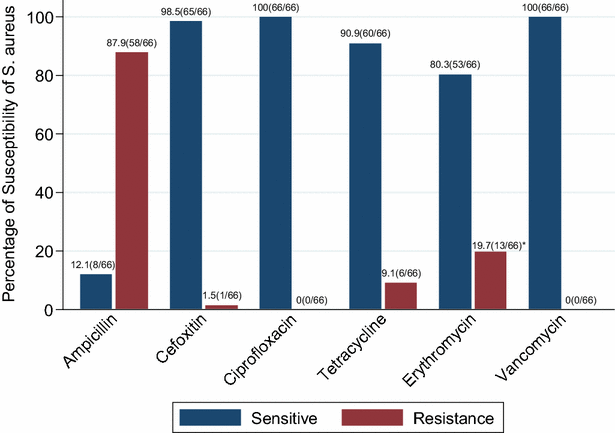Prevalence and antimicrobial susceptibility profiles of Staphylococcus aureus nasal carriage among pre-clinical and clinical medical students in a Tanzanian University
- PMID: 26817605
- PMCID: PMC4728816
- DOI: 10.1186/s13104-016-1858-0
Prevalence and antimicrobial susceptibility profiles of Staphylococcus aureus nasal carriage among pre-clinical and clinical medical students in a Tanzanian University
Abstract
Background: Methicillin resistant Staphylococcus aureus (MRSA) nasal carriage is a potential niche for spread and a risk factor for subsequent infections. Despite the fact that medical students are exposed to patients in the hospital during their training, information on S. aureus and MRSA nasal carriage among medical students in Tanzania remains to be dearth so as to guide appropriate infection control and preventive measures.
Methods: A cross-sectional study involving 314 medical students, pre-clinical (n = 166) and clinical (n = 148), at Catholic University of Health and Allied Sciences (CUHAS) was conducted from February to June 2013. Nasal swabs from eligible students were taken and processed using standard operating procedures so as to identify S. aureus, MRSA and their respective antimicrobial susceptibility patterns.
Results: The median age (interquartile range) of the study participants was 24 (22-27) years with approximately 69.4% being males. S. aureus accounted for 21.0% (66/314) of which 1.5% (1/66) was MRSA; giving an overall MRSA nasal carriage prevalence of 0.3% (1/314). Staphylococcus aureus carriage among pre-clinical and clinical students were 19.9% (33/166) and 22.3% (33/148) respectively. MRSA carriage was found in one preclinical student with history of working in hospital for years prior to join CUHAS. Staphylococcus aureus carriage was significantly more in older median age group among clinical students compared to preclinical students (p < 0.001). Majority of the isolates were resistant to Ampicillin (87.9%, 58/66) while all were sensitive to Ciprofloxacin and Vancomycin.
Conclusion: There is high prevalence of S. aureus carriage among medical students at CUHAS. Fortunately, MRSA was found in only one student. In the light of these findings, focused MRSA surveillance to other potential sources like health care workers, patients and environment should be carried out in this setting.
Figures
Similar articles
-
Prevalence of nasal carriage of methicillin-resistant Staphylococcus aureus and its antibiotic susceptibility pattern in healthcare workers at Namazi Hospital, Shiraz, Iran.Int J Infect Dis. 2009 Sep;13(5):e241-7. doi: 10.1016/j.ijid.2008.11.026. Epub 2009 Mar 9. Int J Infect Dis. 2009. PMID: 19269873
-
Methicillin resistant Staphylococcus aureus: carriage rates and characterization of students in a Texas university.Clin Lab Sci. 2009 Summer;22(3):176-84. Clin Lab Sci. 2009. PMID: 19827412
-
High nasal carriage of methicillin-resistant Staphylococcus aureus among healthy Tanzanian under-5 children.Microb Drug Resist. 2014 Feb;20(1):82-8. doi: 10.1089/mdr.2013.0016. Epub 2013 Sep 13. Microb Drug Resist. 2014. PMID: 24033147
-
Prevalence, antibiogram, and risk factors of methicillin-resistant Staphylococcus aureus (MRSA) asymptomatic carriage in Africa: a systematic review and meta-analysis.BMC Infect Dis. 2025 Apr 11;25(1):505. doi: 10.1186/s12879-025-10819-4. BMC Infect Dis. 2025. PMID: 40217166 Free PMC article.
-
Intestinal carriage of Staphylococcus aureus: how does its frequency compare with that of nasal carriage and what is its clinical impact?Eur J Clin Microbiol Infect Dis. 2009 Feb;28(2):115-27. doi: 10.1007/s10096-008-0602-7. Epub 2008 Aug 8. Eur J Clin Microbiol Infect Dis. 2009. PMID: 18688664 Review.
Cited by
-
Nasal carriage rate, associated factors, and antimicrobial susceptibility patterns of methicillin resistance Staphylococcus aureus among pre-clinical undergraduate students at the College of Health and Medical Sciences, Haramaya University, Ethiopia.Front Public Health. 2024 May 23;12:1354461. doi: 10.3389/fpubh.2024.1354461. eCollection 2024. Front Public Health. 2024. PMID: 38846602 Free PMC article.
-
Hospital Epidemiology of Methicillin-Resistant Staphylococcus aureus in a Tertiary Care Hospital in Moshi, Tanzania, as Determined by Whole Genome Sequencing.Biomed Res Int. 2018 Jan 2;2018:2087693. doi: 10.1155/2018/2087693. eCollection 2018. Biomed Res Int. 2018. PMID: 29487865 Free PMC article.
-
Nasal Carriage of Methicillin-Resistant Staphylococcus aureus among Health Care Workers in Tertiary and Regional Hospitals in Dar es Salam, Tanzania.Int J Microbiol. 2018 Sep 10;2018:5058390. doi: 10.1155/2018/5058390. eCollection 2018. Int J Microbiol. 2018. PMID: 30275835 Free PMC article.
-
Colonization of methicillin-resistant Staphylococcus aureus among healthcare students: an integrative review.Sao Paulo Med J. 2021 Nov 15;139(6):607-614. doi: 10.1590/1516-3180.2020.0564.R2.22042021. eCollection 2021. Sao Paulo Med J. 2021. PMID: 34787295 Free PMC article. Review.
-
Hospital clones of methicillin-resistant Staphylococcus aureus are carried by medical students even before healthcare exposure.Antimicrob Resist Infect Control. 2017 Jan 23;6:15. doi: 10.1186/s13756-017-0175-2. eCollection 2017. Antimicrob Resist Infect Control. 2017. PMID: 28138384 Free PMC article.
References
-
- Gerberding JL, McGowan JE, Jr, Tenover FC. Emerging nosocomial infections and antimicrobial resistance. Curr Clin Top Infect Dis. 1999;19:83–98. - PubMed
-
- Moreillon P, Que Y, Glauser MP. In Mandell, Bennet and Dolin’s Principles and Practice of Infectious Diseases. In: Staphylococcus aureus (Including Staphylococcal Toxic Shock). vol. 6. Philadelphia: Churchill Livingstone, An Imprint of Elsevier. 2005.
MeSH terms
Substances
LinkOut - more resources
Full Text Sources
Other Literature Sources
Medical


